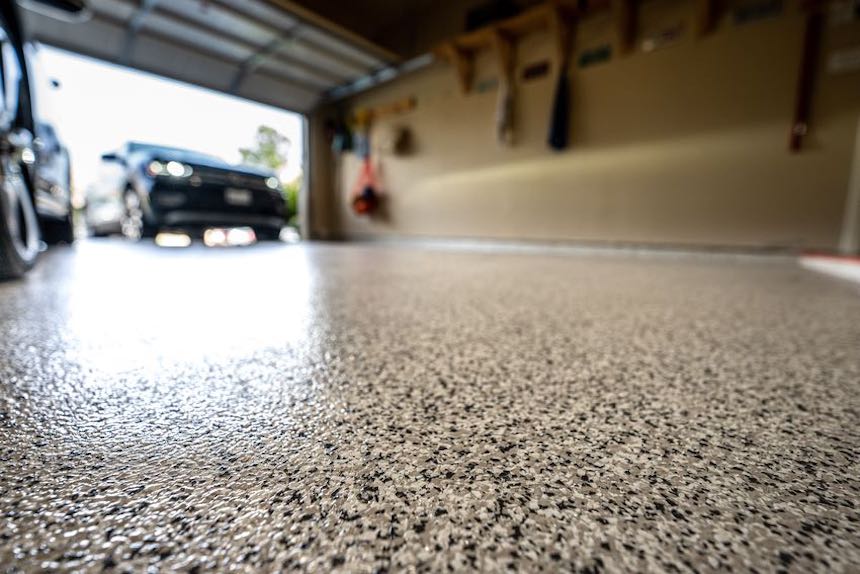
As a homeowner, you are always looking for ways to improve your living space, and one area that often gets overlooked is the garage. A garage is more than just a place to park your car; it can also be a workshop, a storage area, or even a home gym. One of the best ways to improve the appearance and functionality of your garage is by upgrading the floor with garage floor epoxy. In this comprehensive guide, we will discuss everything you need to know about epoxy flooring – from its benefits and types to installation and maintenance.
What is Garage Floor Epoxy?
Garage floor epoxy is a durable, long-lasting, and chemical-resistant coating that is applied to concrete garage floors. It is made from a combination of epoxy resin and a hardener, which, when mixed, form a strong bond with the concrete surface. This bond creates a protective layer that not only improves the appearance of the floor but also increases its resistance to staining, chemicals, and abrasion. Garage epoxy is a popular choice for both residential and commercial garages, thanks to its durability, affordability, and aesthetic appeal.
Benefits of Garage Floor Epoxy
There are numerous advantages to using epoxy as a garage floor covering, including:
– Durability: Epoxy floor coatings are incredibly strong and resistant to wear and tear, making them perfect for high-traffic areas like garages.
– Aesthetic appeal: Epoxy flooring is available in a variety of colors and styles, allowing homeowners to customize their garage floors to match their personal preferences and home decor.
– Chemical resistance: Garage floor epoxy is resistant to chemicals, oil, and gasoline, which can be common in a garage setting.
– Easy maintenance: Epoxy floors are low maintenance, requiring only occasional sweeping and mopping to keep them looking their best.
– Enhanced safety: Epoxy coatings can include anti-slip additives, increasing the safety of your garage floor.
– Cost-effective: Compared to other garage flooring options, epoxy is relatively affordable and provides long-lasting value.
Types of Garage Floor Epoxy
There are several types of garage floor epoxy to choose from, including:
– Water-based epoxy: This type is easy to apply, has a lower odor, and is more environmentally friendly than other options. However, it may not be as durable as other types of epoxy.
– Solvent-based epoxy: This type of epoxy offers improved durability, but it can be more challenging to apply and has a stronger odor.
– 100% solid epoxy: This is the most durable type of epoxy, offering excellent resistance to chemicals, abrasion, and UV exposure. However, it is also the most difficult to apply and may be best suited for professional installation.
Factors to Consider Before Installing Epoxy Flooring
Before you decide to install garage floor epoxy, there are several factors to consider:
– Condition of the concrete: The concrete surface must be in good condition, with no cracks, moisture issues, or other damage that could affect the epoxy’s bond.
– Proper preparation: The concrete surface must be properly prepared, including cleaning, repairing any damage, and etching or grinding the surface to ensure a strong bond with the epoxy.
– Temperature and humidity: The temperature and humidity levels during installation can affect the curing process, so it’s essential to choose a time when conditions are ideal.
– Ventilation: Proper ventilation is necessary during the installation process, as epoxy fumes can be hazardous.
DIY vs. Professional Epoxy Floor Installation
There are two main options for installing garage floor epoxy: DIY (do-it-yourself) or hiring a professional. Here are the pros and cons of each:
DIY:
– Pros: Lower cost, ability to customize the project, and a sense of accomplishment.
– Cons: Time-consuming, potentially challenging installation process, and potential for mistakes.
Professional:
– Pros: Expertise in installation, higher-quality materials, and a warranty on the work.
– Cons: Higher cost and less control over the project.
How to Install Garage Floor Epoxy: A Step-by-Step Guide
If you decide to tackle epoxy installation as a DIY project, follow these steps:
1. Clean and prep the surface: Remove all dirt, grease, and debris from the concrete floor. Repair any cracks or damage, and then etch or grind the surface to ensure proper adhesion.
2. Mix the epoxy: Follow the manufacturer’s instructions for mixing the epoxy resin and hardener.
3. Apply the epoxy: Use a roller or brush to apply the epoxy to the floor, starting in a corner and working your way out. Apply multiple coats if necessary, allowing each coat to dry according to the manufacturer’s instructions.
4. Add decorative flakes or anti-slip additives (optional): If desired, add decorative flakes or anti-slip additives to the final coat of epoxy.
5. Allow the epoxy to cure: The curing process can take anywhere from 24 hours to several days, depending on the type of epoxy and environmental conditions. Avoid walking or driving on the floor during this time.
Maintaining and Cleaning Epoxy Garage Floors
Epoxy garage floors are relatively low maintenance, but proper care is essential to keep them looking their best. Here are some tips for maintaining and cleaning epoxy garage floors:
– Sweep regularly to remove dirt and debris.
– For spills or stains, use a mild detergent and water to clean the surface.
– Avoid using harsh chemicals or abrasive cleaners, as they can damage the epoxy coating.
– If the floor begins to show signs of wear or damage, consider applying a new topcoat to refresh the surface.
Garage floor epoxy is an excellent option for upgrading your garage floor, offering durability, aesthetic appeal, and easy maintenance. With proper installation and care, epoxy flooring can last for years, providing a valuable investment for your home. Whether you choose to tackle the project as a DIY or hire a professional, epoxy garage floors are a worthwhile upgrade that can transform your garage into a more functional and attractive space.
- How To Properly Put On and Take Off a Disposable Respirator - March 15, 2024
- Unlocking the Doors to Your Dream Destination: Why You Need a Skilled Migration Visa Lawyer - February 15, 2024
- Navigating Family Dynamics in Choosing the Right Aged Care Services - December 9, 2023






